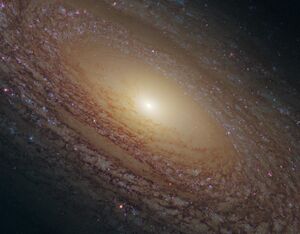Astronomy:NGC 2841
| NGC 2841 | |
|---|---|
 Hubble Space Telescope image of NGC 2841 | |
| Observation data (J2000 epoch) | |
| Constellation | Ursa Major |
| Right ascension | 09h 22m 02.655s[1] |
| Declination | +50° 58′ 35.32″[1] |
| Redshift | 0.002130[2] |
| Helio radial velocity | 638 km/s[3] |
| Distance | 46.0 ± 4.9 Mly (14.1 ± 1.5 Mpc)[4][5] |
| Apparent magnitude (V) | 10.1[3] |
| Characteristics | |
| Type | SAa[2] |
| Mass | 7×1010 M☉[6] M☉ |
| Apparent size (V) | 8.1′ × 3.5′[6] |
| Notable features | Flocculent galaxy with LINER nucleus |
| Other designations | |
| UGC 4966, PGC 26512[3] | |
NGC 2841 is an unbarred spiral galaxy in the northern circumpolar constellation of Ursa Major. It was discovered on 9 March 1788 by German-born astronomer William Herschel. J. L. E. Dreyer, the author of the New General Catalogue, described it as, "very bright, large, very much extended 151°, very suddenly much brighter middle equal to 10th magnitude star".[7] Initially thought to be about 30 million light-years distant, a 2001 Hubble Space Telescope survey of the galaxy's Cepheid variables determined its distance to be approximately 14.1 megaparsecs or 46 million light-years.[4] The optical size of the galaxy is 8.1′ × 3.5′.[6]
This is the prototype for the flocculent spiral galaxy,[5] a type of spiral galaxy whose arms are patchy and discontinuous.[8] The morphological class is SAa, indicating a spiral galaxy with no central bar and very tightly-wound arms. There is no grand design structure visible in the optical band, although some inner spiral arms can be seen in the near infrared.[5] It is inclined by an angle of 68° to the line of sight from the Earth, with the major axis aligned along a position angle of 148°.[5]
The properties of NGC 2841 are similar to those of the Andromeda Galaxy.[4] It is home to a large population of young blue stars, and a few H II regions.[9] The luminosity of the galaxy is 2×1010 solar luminosity and it has a combined mass of 7×1010 M☉.[6] Its disk of stars can be traced out to a radius of around 228 kly (70 kpc). This disk begins to warp at a radius of around 98 kly (30 kpc), suggesting the perturbing effect of in-falling matter from the surrounding medium.[5]
The rotational behavior of the galaxy suggests there is a massive nuclear bulge,[6] with a low-ionization nuclear emission-line region (LINER) at the core; a type of region that is characterized by spectral line emission from weakly ionized atoms.[10] A prominent molecular ring is orbiting at a radius of 7–20 kly (2–6 kpc), which is providing a star-forming region of gas and dust.[6] The nucleus appears decoupled and there is a counter-rotating element of stars and gas in the outer parts of the nucleus, suggesting a recent interaction with a smaller galaxy.[6]
Four supernovae have been observed in NGC 2841: SN 1912A (type Ia, mag. 13),[11] SN 1957A (type Ia, mag. 14),[12] SN 1972R (mag. 16),[13] and SN 1999by (type Ia, mag. 15).[14]
References
- ↑ 1.0 1.1 Skrutskie, Michael F.; Cutri, Roc M.; Stiening, Rae; Weinberg, Martin D.; Schneider, Stephen E.; Carpenter, John M.; Beichman, Charles A.; Capps, Richard W. et al. (1 February 2006). "The Two Micron All Sky Survey (2MASS)". The Astronomical Journal 131 (2): 1163–1183. doi:10.1086/498708. ISSN 0004-6256. Bibcode: 2006AJ....131.1163S.
- ↑ 2.0 2.1 Ann, H. B. et al. (2015). "A Catalog of Visually Classified Galaxies in the Local (z ~ 0.01) Universe". The Astrophysical Journal Supplement Series 217 (2): 27. doi:10.1088/0067-0049/217/2/27. Bibcode: 2015ApJS..217...27A.
- ↑ 3.0 3.1 3.2 "NASA/IPAC Extragalactic Database". Results for NGC 2841. http://nedwww.ipac.caltech.edu/. Retrieved 2006-10-04.
- ↑ 4.0 4.1 4.2 Macri, L. M.; Stetson, P. B.; Bothun, G. D.; Freedman, W. L. et al. (September 2001). "The Discovery of Cepheids and a New Distance to NGC 2841 Using the Hubble Space Telescope". Astrophysical Journal 559 (1): 243–259. doi:10.1086/322395. ISSN 0004-637X. Bibcode: 2001ApJ...559..243M.
- ↑ 5.0 5.1 5.2 5.3 5.4 Zhang, Jielai et al. (March 2018). "The Dragonfly Nearby Galaxies Survey. IV. A Giant Stellar Disk in NGC 2841". The Astrophysical Journal 855 (2): 8. doi:10.3847/1538-4357/aaac81. 78. Bibcode: 2018ApJ...855...78Z.
- ↑ 6.0 6.1 6.2 6.3 6.4 6.5 6.6 Kaneda, H. et al. (October 2007). "Far-Infrared Distributions in Nearby Spiral Galaxies NGC 2841 and NGC 2976 Observed with AKARI/Far-Infrared Surveyor (FIS)". Publications of the Astronomical Society of Japan 59 (s2): S463. doi:10.1093/pasj/59.sp2.S463. Bibcode: 2007PASJ...59S.463K.
- ↑ Seligman, Courtney. "NGC Objects: NGC 2800 - 2849". Celestial Atlas. http://cseligman.com/text/atlas/ngc28.htm#2841. Retrieved 2016-03-01.
- ↑ A Near-Infrared Atlas of Spiral Galaxies. http://nedwww.ipac.caltech.edu/level5/Elmegreen/Elm3.html. Retrieved 23 April 2010. See CH3. Discussion.
- ↑ Marochnik, Leonid; Suchkov, Anatoly (1995-11-01). Milky Way Galaxy (1st ed.). Routledge. p. 267. ISBN 978-2-88124-931-0.
- ↑ Ho, L. C. et al. (1997). "A Search for "Dwarf" Seyfert Nuclei. III. Spectroscopic Parameters and Properties of the Host Galaxies". Astrophysical Journal Supplement 112 (2): 315–390. doi:10.1086/313041. Bibcode: 1997ApJS..112..315H.
- ↑ Transient Name Server entry for SN 1912A. Retrieved 25 March 2023.
- ↑ Transient Name Server entry for SN 1957A. Retrieved 25 March 2023.
- ↑ Transient Name Server entry for SN 1972R. Retrieved 25 March 2023.
- ↑ Transient Name Server entry for SN 1999by. Retrieved 25 March 2023.
External links
- NGC 2841 on WikiSky: DSS2, SDSS, GALEX, IRAS, Hydrogen α, X-Ray, Astrophoto, Sky Map, Articles and images
Coordinates: ![]() 9h 22m 02.6s, +50° 58′ 35″
9h 22m 02.6s, +50° 58′ 35″
 |


